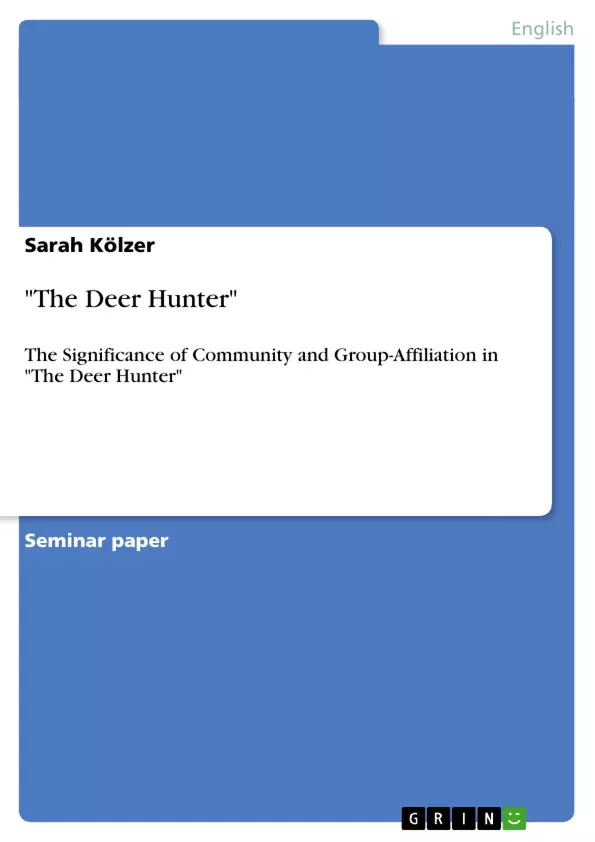The movie The Deer Hunter was released in 1978; three years after the end of
the Vietnam War. During the war, the American public had received censored
information by the mass media concerning the war. The American sense of
mission and patriotism hovered above and disguised uncomfortable topics such
as the cruelties inflicted on Vietnamese civilians by GIs or less palatable the
justifications for the U.S. intervention in the war. It therefore left no space for
any respect towards the Vietnamese as an individual being part of an ethnic
group with its own culture. Although stereotypes about the Vietnamese are
adopted and developed in The Deer Hunter so much so that even critics stood
up for the former “enemy” and condemned the depiction as “racist” – the
enemy is not, unlike in several other movies produced at that time, simply an
excuse for demonizing particularly the Vietnamese; it serves as a rather
symbolical threat to a community of “war buddies” and could be replaced by
any other enemy.
In this paper I will argue that labeling The Deer Hunter as “racist” is
misconceived, since the adoption of the Vietnamese as an enemy image has to
be reduced to the threat itself. The first two chapters will explain how the
attitude of the American public towards the Vietnamese as their “enemy” was
shaped and why the issue of Vietnam became a central to the plot. This will
show that the emphasis is laid on something else: human relationships within
the group and not, as it at first seems to be, on the enemy itself. Therefore, I
will explore the significance of community in this particular case and compare
the relationships within the group before, during and after the war. It will
become clear that the original hierarchy of the group dissolves when the group
is threatened. The group´s war experiences lead further to an inability to take
part in the social life at home. Since the original group is shattered, the new
group is challenged to refer to the former bonds that have always kept them
together in order to establish a new identity. Ironically, this new identity is
based on the patriotic phrase “God bless America”.
Inhaltsverzeichnis (Table of Contents)
- Introduction
- Vietnam Stereotyped
- Why Vietnam?
- The Community
- The Characters
- The Background
- Breaking-up of the Group
- Re-establishing
- Reunification
- Conclusion
Zielsetzung und Themenschwerpunkte (Objectives and Key Themes)
This paper aims to analyze the portrayal of Vietnamese characters in the movie "The Deer Hunter", released in 1978. The paper argues that the film's depiction of the Vietnamese, while seemingly "racist", should be understood in the context of the American public's perception of the Vietnam War and its impact on a group of American veterans.
- The impact of the Vietnam War on American society
- The shaping of public opinion through media censorship
- Stereotypes and enemy images in wartime
- The importance of community and group dynamics
- The influence of the Vietnam War on veteran identity
Zusammenfassung der Kapitel (Chapter Summaries)
The first chapter introduces the film "The Deer Hunter" and sets the context for analyzing the portrayal of the Vietnamese. It discusses the American public's perception of the Vietnam War and how media censorship shaped their understanding of the conflict. The second chapter delves into the creation and perpetuation of stereotypes about the Vietnamese during the war, highlighting the role of media manipulation in constructing a simplified enemy image. The third chapter explores the motivations behind the film's choice of the Vietnam War as a backdrop, explaining how the war's complex realities presented an opportunity to explore themes of community and identity within a group of American veterans.
Schlüsselwörter (Keywords)
The main keywords and focus topics of this paper include: "The Deer Hunter", Vietnam War, stereotypes, enemy images, community, group dynamics, veteran identity, media censorship, American public opinion.
- Quote paper
- Sarah Kölzer (Author), 2005, "The Deer Hunter", Munich, GRIN Verlag, https://www.grin.com/document/135085



